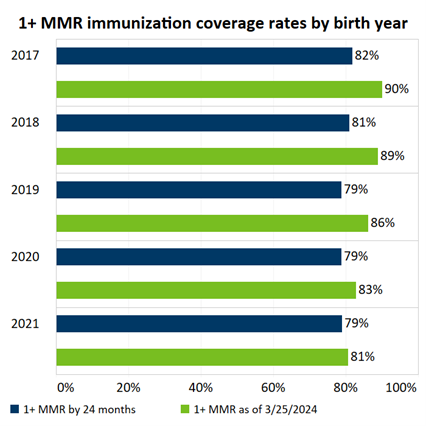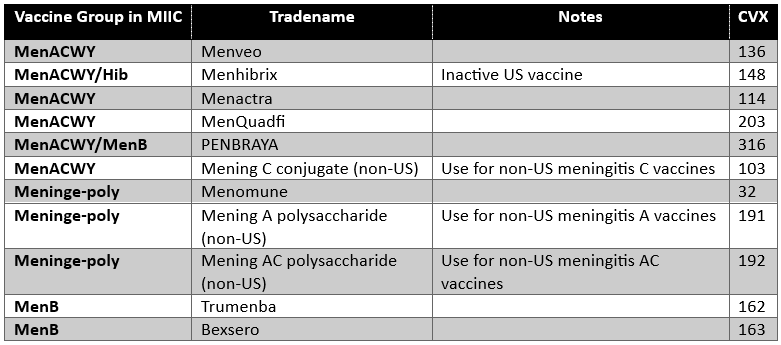|
View this as a webpage
May 1, 2024
Please join us for our four-part MIIC webinar series! Registration is not required. Staff will cover several aspects of MIIC in each session, including time for questions at the end. Sessions will also be recorded.
Webinar #1 was held April 23 from 11:00-12:00 p.m.
Webinar #2 April 30 from 11:00-12:00 p.m.
- Covered Administrator and Health System User roles, editing client demographics, creating new client records, and reviewing the client immunization history and MIIC Forecaster.
- The recording, transcript and access to the evaluation/CEU credits will be posted on MIIC User Guidance and Training Resources when available.
Webinar #3 May 10 from 11:00-12:00 p.m.
Webinar #4 May 21 from 11:00–12:00 p.m.
Continuing Education Units (CEUs) will be available to providers who participate in either the live MIIC webinar sessions or the posted recordings. To receive credit, participants will be required to fill out a brief survey evaluation.
Please come with questions or submit your questions in advance to the MIIC Help Desk at health.miichelp@state.mn.us.
Join us for the webinar Implement “Start at Age 9” Approach in Your Practice: Strategies to Improve HPV Vaccination Rates on May 22, 12:00 to 1:00 p.m. Dr. Vanessa Slots, M.D, a pediatrician from M Health Fairview, will share her experiences starting the HPV vaccine series at age 9, the challenges and solutions she’s navigated, and benefits she’s experienced in her practice. Come learn how Dr. Slots’ experience mirrors core strategies for improving vaccination coverage rates. All clinic staff are welcome and encouraged to join! Everyone from front desk staff and care coordinators to medical assistants and ordering providers play an important role in promoting HPV vaccination. CEUs will be available for attendees.
Use this link to register for the webinar. This is the second webinar in our HPV vaccination improvement series. For more information about the program and to access the first webinar’s recording, visit HPV Vaccination Improvement Project. This webinar is co-hosted by the Minnesota Department of Health and the Minnesota chapter of the American Cancer Society.
Before summer break, change your MIIC password. Your MIIC login expires every 60 days. Ten days before the password expires, you will receive an email from health.miichelp@state.mn.us prompting you to login to MIIC and change your password. View the Manage My Account User Guide (PDF) for help.
If you do not change the password before it expires, the next time you login to MIIC you will be prompted to create a new password. You must set a new password before you can access any other functions within MIIIC.
Users will be directed to their MIIC Administrator if they experience any issues logging in. If you are the MIIC Administrator for your organization, please communicate to your users the importance of keeping their accounts active.

Immunizations remain our best way to prevent vaccine-preventable diseases, like measles. Children are routinely recommended to get at least one dose of Measles-Mumps-Rubella (MMR) vaccine by 24 months.
Statewide (at least one dose) MMR immunization coverage rates show that on-time (by 24 months) immunization coverage rates are far below the 90% needed to reach the Healthy People 2030: Maintain the vaccination coverage level of 1 dose of the MMR vaccine in children by age 2 years objective. While some children eventually get caught up, on-time vaccination is important to ensuring the best possible protection against diseases like measles. Strategies used to improve rates are listed in the promote actions to improve rates section.
There are several ways you can use MIIC to help improve MMR immunization coverage rates:
- MIIC can be used to monitor and improve immunization coverage in Minnesota.
- The Immunization Assessment feature can be used to assess your organization’s immunization rates.
- The Client Follow-Up feature can be used to conduct reminder/recall. Visit the Learning Corner for more information on how to use Client Follow-Up for improving MMR rates.
- Make sure MIIC accurately reflects your clients’ immunization information. Here are some steps you can take.
- If your organization submits data to MIIC via electronic data exchange, verify with your IT departments and/or EHR vendors that the information entered in your EHR is being sent and accepted by MIIC.
- If you need to enter the immunizations through the user interface (direct data entry), you can refer to the Adding Immunizations Not Using Inventory user guidance.
- Immunizations your organization did not administer can still be reported to MIIC if you’ve received acceptable proof of vaccination. Learn more about Capturing Immunizations Not Currently in MIIC (PDF).
- If you can’t enter immunizations into MIIC your user role might not allow for it. Check with your MIIC Administrator to get your role updated if necessary. If you do not know who your Administrator is, email health.miichelp@state.mn.us with your organization code and we will direct you to your Administrator.
- If you don’t know if you can enter/update immunizations, email health.miichelp@state.mn.us with your organization code and we will work with you.
For more information on these features visit MIIC User Guidance and Training Resources.
|
There are many resources available to providers that can help improve vaccine coverage rates. Read on to learn about some of the programs or action steps your organization can take.
Quality data = quality records
Sending accurate and complete client data is necessary for MIIC to provide important services to you and your patients. Up to date demographic information and specific vaccination information is needed to calculate accurate vaccination rates, which are used to identify pockets of need and direct resources. Sending accurate and complete records also prevents record fragmentation and immunization duplication and allows providers and their patients to view a more comprehensive immunization record to receive the correct vaccines at the right time.
Please confirm and update all demographic information (including current address and phone number) every time a client receives services at your organization. Additionally, please enter all immunizations, including those being entered historically, as accurately and completely as possible.
Monitor your data feeds
For organizations submitting immunization and client data to MIIC electronically via their EHR, we would like to remind you to check that data is flowing to MIIC in timely and accurate manner. MIIC sends acknowledgment messages, including information on message errors and rejections, for each message we receive. Monitoring these messages regularly can ensure that the information you are sending to us is being received without issue. If you are receiving rejection messages or see errors in the acknowledgments, reaching out to us quickly makes it much easier to investigate the issue and determine a solution.
Subscribe to receive MIIC Data Submission and Exchange email updates so that you receive relevant communication that could affect the flow of data to and from MIIC.
Texting, everyone’s doing it!
MIIC sends text message immunization reminders as an optional free service for health organizations and schools in Minnesota. Text messages are available in several languages including English, Spanish, Somali, and Hmong. For more information, please visit: Reminder/Recall Using Text Messages (PDF).
To enroll, email health.miictexting@state.mn.us with your organization name and your texting campaign(s) of interest.
Let's work together to improve the quality of immunization practices
The Immunization Quality Improvement for Providers (IQIP) program is a tool that promotes and supports the implementation of provider-level quality improvement strategies designed to increase vaccine uptake among childhood and adolescent patients. The IQIP program kicks off with a site visit (in-person or virtual) to set goals and select activities to focus on throughout the next year. If your organization already has quality improvement goals and programming, IQIP can help clinics plan activities that aim at achieving those goals. Check-ins throughout the year keep improvement activities from getting lost in the shuffle of daily practice work.
IQIP is available to all eligible MnVFC providers. IQIP cycles are led by consultants located throughout the state. Reach out to health.IQIP.mailbox@state.mn.us to connect with an IQIP consultant today!
With the recent increase of new international arrivals to Minnesota, some health care organizations are dealing with entering immunization records that include non-US vaccines. MIIC would like to assure users that entry of these non-US vaccines into our system is both permitted and highly encouraged wherever possible. However, only vaccine types that have been issued a CVX code by CDC can be entered into MIIC. This may mean entering a less specific vaccine than what is listed in a client’s record. A full list of the CVX codes can be found on CDC Immunization Information Systems (IIS): HL7 Standard Code Set Mapping CVX to Vaccine Groups.
Most of the questions we have received about non-US vaccines have been about meningitis vaccines, so we will go into further depth on those in this article.
Data exchange
If your organization is sending data via an electronic interface or submitting data via the immunization spreadsheet, MIIC can accept any meningitis vaccine with a CVX code from the list linked above. CDC lists those CVX codes under “MENING” or “MeningB”. You may have to consult with your IT team or EHR vendor to determine how to enter these in your system. If the exact vaccine type is not listed, an unspecified CVX code may suit. Do not send a “near match” or an unspecified code that doesn’t accurately cover the vaccine. You do not need to send tradename information for non-US vaccines.
User interface
You may also enter shots directly into the MIIC user interface, though this is onerous and prone to error if you have many entries to make.
Once you click “add immunization” in a client’s MIIC record, you have three meningitis vaccine groups to choose from, MenACWY, MenB, and Meninge-poly.
|
|
 |
Entering the number of shots into these boxes and selecting okay will take you to a page where you can enter date information (required, do not enter estimated dates) and select tradenames. If you do not have a tradename, you can leave the tradename field blank. ONLY do this if the client received an ACWY, B, or quadrivalent polysaccharide vaccine that doesn’t fit the options in the table below. The vaccines will appear in the client’s record as unspecified types.
Before going this route, please review the tradename option under each group, as you may find a better fit there.
 Immunization validity
Meningitis vaccine types and schedules vary from country to country. Unless a client has received MenACWY and/or MenB vaccines (including unspecified formulations) on the recommended US schedule, it is likely that their vaccines will appear with the NOT VALID indicator in MIIC. Healthcare providers can email the MDH Vaccine SME team at health.vaccineSME@state.mn.us with questions on whether these clients need to be revaccinated. For questions about school requirements for meningitis vaccination in Minnesota, please email health.aisr@state.mn.us.
Several noticeable updates to MIIC have been made recently. Here is what you might have noticed:
- MIIC has updated the logo on the login page to show case the counties and tribal nations in Minnesota rather than regional entities.
- When utilizing the ‘forgot password’ function on the login page you should no longer receive a blank or grey box. The function should show one of your security questions. If you have not set up a security question you will receive an error message telling you to contact your MIIC Administrator or the MIIC Help Desk for further assistance.
- You should now be able to use the search screens within the user interface to search for clients with apostrophes in their names!
- The automated email that you get as your password is about to expire will now have an accurate number of days left before the password expired. Previously the email stated that you had 10 days left every day for each of the 10 days you receive email reminders.
- We have updated the Vaccine Administration Request Form to remove some old branding; correct some formatting, readability, spelling, and spacing issues; and update outdated dose-level eligibility (DLE) code and VIS dates.
|